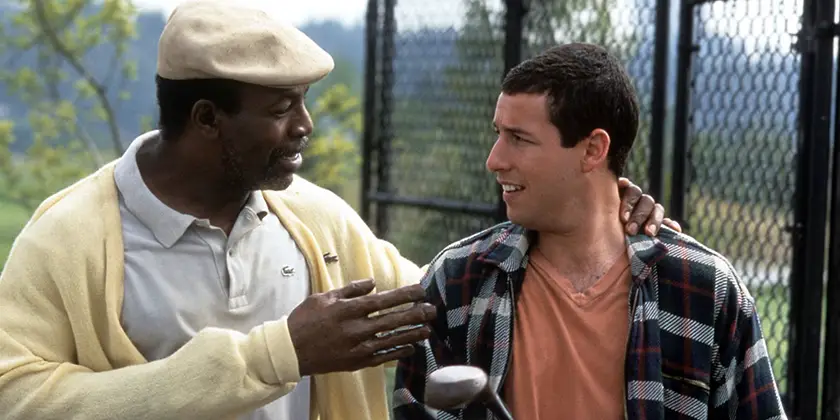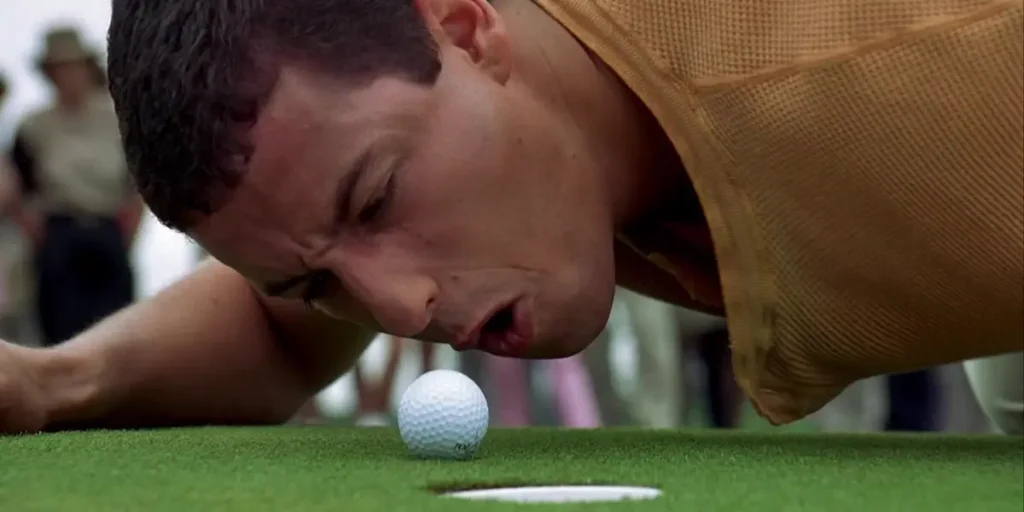Adam Sandler’s comedy Happy Gilmore is filled with problematic themes, but it’s plenty of fun, as well as a surprisingly insightful commentary on class.
Director: Dennis Dugan
Genre: Comedy, Sport, Slapstick
Run Time: 92′
U.S. Release: February 16, 1996
U.K. Release: July 19, 1996
Where to Watch: Digital & VOD
Every time I watch the 1996 comedy classic Happy Gilmore, I think of an article from The Onion titled, “Woman Takes Short Half-Hour Break From Being Feminist To Enjoy TV Show.” Are there problems with this movie? God, yes. Is it still one of my favorite ’90s Adam Sandler flicks? Absolutely.
The film begins with a voiceover in which Happy Gilmore (Adam Sandler) shares a bit of his backstory. Orphaned as a child, he found a home with his Grandma (Frances Bay), who welcomed him by wearing a mask of Gene Simmons from KISS. We learn that he loves two things: Grandma and hockey. But despite his dedication to both, Happy finds himself unable to break into the minor league hockey team, and when Grandma finds herself on the wrong side of the IRS, he is unable to save her home from being seized by the government.
Like so many films from director Dennis Dugan, this loser has a secret talent: because of his relentless practicing for hockey, Happy has a monster drive. When Chubbs (Carl Weathers), a local golf pro, sees Happy at a driving range, he sees a man who has the skill to be a professional on the golf circuit. Chubbs encourages Happy to enter, telling him that he can win money to help save Grandma’s house. Happy agrees and scandalizes the course, and likely winner of the Tour Championship, Shooter McGavin (Christopher McDonald). But he also catches the eye—and eventually the heart—of the public relations representative, Virginia Venit (Julie Bowen), and the public at large.
There are plenty of reasons why Happy Gilmore was not a critical darling when it was released. The titular character is a textbook abuser who hits first and then apologizes, promising he’ll be better next time. When Happy goes to his “happy place” to center himself to putt, Virginia is reduced to a model in lingerie, holding pitchers of beer. The nursing home that Grandma stays at while Happy tries to save her house is managed by a sadistic orderly (played by an uncredited Ben Stiller), who essentially turns the residents into slaves, turning out handmade quilts. Shooter is so cartoonishly evil that it’s hard to take anything that he says or does seriously.

However, despite the numerous issues present in this script, Sandler possesses a charm that allows Happy Gilmore to far exceed the sum of its parts. The Pro-Am event with the former host of The Price Is Right, Bob Barker, is delightfully unhinged. The 7’2” Richard Kiel’s role as Happy’s boss, Mr. Larson, is both menacing and endearing. And Happy’s choice of an unhoused man to be his caddy (Allen Covert) brings the heart of the movie to the forefront.
Golf has the perception of being a sport for a particular socio-economic class of people. The cost of fees and memberships, combined with the amount of time necessary to play, prohibits a number of working-class folks from participating in the game. Happy Gilmore places the issue of class right at the center of the film, not only with our hero, but with the spectators who start to show up when Happy starts winning competitions. Shooter isn’t just the antagonist for Happy; he is the embodiment of a system that puts a fine line between the haves and the have-nots. We find ourselves rooting for Happy, not because we necessarily like him, but because, for a lot of Americans, we can see ourselves in him.
I mentioned at the top that I try to turn my brain off when watching older movies with some broadly problematic areas, but the truth is, I never turn my brain off when watching a movie. Viewing Happy Gilmore remains an interesting experience because it’s hard to miss some of the most glaring problems with the film, but when you start to dig, you can see some of its redeeming qualities. And they all converge when Bob Barker punches Happy in the face.
Happy Gilmore: Movie Plot & Recap
Synopsis:
When Happy Gilmore’s grandmother is about to lose her house, he discovers that his hockey training has given him a huge golf drive. He goes up against Shooter McGavin to win the Tour Championship, save his Grandma’s home, and maybe even get the girl.
Pros:
- An insightful look at socio-economic class
- Funny and quotable
Cons:
- Portrays an abusive character as the hero
- The one female character is shown largely as an object
Happy Gilmore was re-released in US theaters on April 27-30, 2025 and is now available to watch on digital and on demand. The sequel, Happy Gilmore 2, will be available to stream on Netflix on July 25, 2025.
Loud and Clear Reviews has an affiliate partnership with Apple, so we receive a share of the revenue from your purchase or streaming of the films when you click on some of the links on this page. This won’t affect how much you pay for them and helps us keep the site free for everyone.

